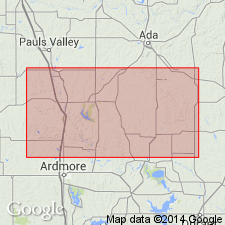
- Usage in publication:
-
- Rhoda Creek formation
- Modifications:
-
- Named
- Dominant lithology:
-
- Shale
- AAPG geologic province:
-
- South Oklahoma folded belt
Summary:
Named as a formation in the Springer Series; named from Rhoda Creek, the largest eastern tributary to Clear Boggy Creek. Type locality designated in NW1/4 sec 8, T2N, R7E, about 1 mi northwest of Frisco, Pontotoc Co, OK in Arkoma basin. Occurs in the northern Arbuckle Mountains of south-central OK. Consists largely of uniformly soft gray shale, with somewhat irregular cleavage along bedding, combined with conchoidal fracture; shale disintegrates readily in water. Ferruginous concretions present at several horizons and locally concentrated in zones or lentils. At type locality, light-gray to rusty, only slightly hardened sandstone and sandy shale 9 ft thick cap about 131 ft of the shale. Total thickness measured at type locality is slightly more than 140 ft. Unconformably overlies Sand Branch member (new) of Caney shale; underlies an unexposed and unnamed shale interval of Springer age. Cephalopods, goniatites, pelecypods, a few conodonts. Stratigraphic table. Age given as pre-Union Valley, pre-Morrow.
Source: GNU records (USGS DDS-6; Denver GNULEX).
For more information, please contact Nancy Stamm, Geologic Names Committee Secretary.
Asterisk (*) indicates published by U.S. Geological Survey authors.
"No current usage" (†) implies that a name has been abandoned or has fallen into disuse. Former usage and, if known, replacement name given in parentheses ( ).
Slash (/) indicates name conflicts with nomenclatural guidelines (CSN, 1933; ACSN, 1961, 1970; NACSN, 1983, 2005, 2021). May be explained within brackets ([ ]).

